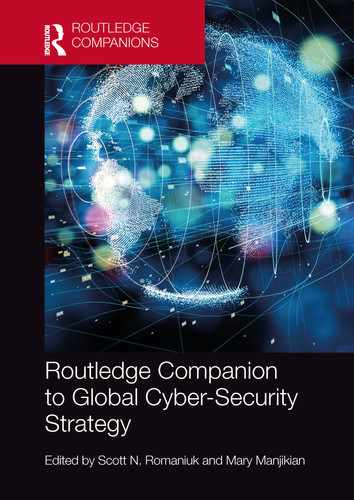This companion provides the most comprehensive and up-to-date comparative overview of the cyber-security strategies and doctrines of the major states and actors in Europe, North America, South America, Africa, and Asia. The volume offers an introduction to each nation’s cyber-security strategy and policy, along with a list of resources in English that may be consulted for those wishing to go into greater depth. Each chapter is written by a leading academic or policy specialist, and contains the following sections:
This book will be of much interest to students and practitioners in the fields of cyber-security, national security, strategic studies, foreign policy, and international relations.
Table of Contents
- Cover
- Half Title
- Title Page
- Copyright Page
- Table of Contents
- List of figures
- List of tables
- List of contributors
- Foreword: Global cybersecurity in the 21st century
- Introduction: cybersecurity strategy and policy in a comparative context
- Part I: Europe
- 1 Securing the kingdom’s cyberspace: cybersecurity and cyber intelligence in Spain
- 2 Albania’s cybersecurity pivot: between Western architectures and great power competition
- 3 Armenian national policy in cyber space: toward a global cyber security architecture
- 4 Czech Republic: a new cyber security leader in Central Europe
- 5 Cyber security in the French Republic
- 6 Germany’s cybersecurity strategy: confronting future challenges
- 7 Cybersecurity of Poland: legal and organizational framework
- 8 Hungary’s evolving cyber security strategy
- 9 Romanian cybersecurity efforts: a work in progress
- 10 Italy’s cyber security architecture and critical infrastructure
- 11 Dutch cyber security strategy
- 12 Norwegian cyber security: a small-state approach to building international cyber cooperation
- 13 Seeking a new order for global cybersecurity: the Russian approach to cyber-sovereignty
- 14 Slovakia: the Tatra Tiger without teeth
- 15 Slovenia: a fragmented cyber security
- 16 In the line of Russian aggression: Ukraine, hybrid warfare, and cybersecurity defense
- 17 United Kingdom: pragmatism and adaptability in the cyber realm
- 18 European Union: policy, cohesion, and supranational experiences with cybersecurity
- 19 Estonia: from the “Bronze Night” to cybersecurity pioneers
- 20 NATO’s evolving cyber security policy and strategy
- Part II: Asia and Australia
- 21 Japan’s challenges, capabilities, and preparedness in cyberspace
- 22 An effective shield? Analyzing South Korea’s cybersecurity strategy
- 23 In the line of fire: Taiwan’s legal, political, and technological cybersecurity posture
- 24 Serving the people: China’s cybersecurity policy and its implications
- 25 Cybersecurity in a one-party state: policies and implications for Vietnam’s economy and online freedom
- 26 The Philippines’ cybersecurity strategy: strengthening partnerships to enhance cybersecurity capability
- 27 Malaysia: balancing national development, national security, and cybersecurity policy
- 28 Cyber governance and data protection in India: a critical legal analysis
- 29 Cybersecurity: a national priority for Bangladesh
- 30 Managing a digital revolution: cyber security capacity building in Myanmar
- 31 Australia’s cyber security: a unique opportunity
- 32 Singapore: a leading actor in ASEAN cybersecurity
- Part III: The Middle East
- 33. Between multi-stakeholderism and cyber sovereignty: understanding Turkey’s cybersecurity strategy
- 34 Israel: cyber defense and security as national trademarks of international legitimacy
- 35 Palestine: whose cyber security without cyber sovereignty?
- 36 The “Silicon Valley of the Middle East”: cybersecurity, Saudi Arabia, and the path to Vision 2030
- 37 The Islamic Republic of Iran’s cyber security strategy: challenges in an era of cyber uncertainty
- Part IV: The Americas
- 38 Canada’s cyber security in a globalized environment: challenges and opportunities
- 39 The United States: a declining hegemon in cyberspace?
- 40 Jamaica’s cybercrime and cyber-security: policies, laws, and strategies
- 41 Mexico and cybersecurity: policies, challenges, and concerns
- 42 Colombia’s cybersecurity predicament: state making, strategic challenges, and cyberspace
- 43 Cyber security governance in Brazil: keeping silos or building bridges?
- Part V: Africa
- 44 Securitizing CyberSpace in Egypt: the dilemma of cybersecurity and democracy
- 45 Security through the Arab Winter: cyber strategies in post-revolutionary Tunisia
- 46 Cyber security in Kenya: balancing economic security and internet freedom
- 47 Cybersecurity policy in Nigeria: a tool for national security and economic prosperity
- 48 Cybersecurity in Ghana: past, present, and future
- 49 Building a Cyber Fortress in Africa: Uganda’s cyber security capacities and challenges
- 50 Cybersecurity in South Africa: status, governance, and prospects
- 51 Algorithms of oppression? AU’s cybersecurity policy and its enforcement in Africa
- Index
